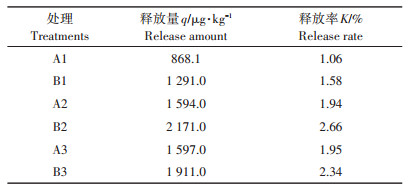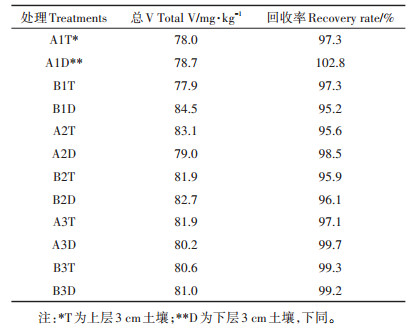2. 地下水污染控制与修复教育部工程研究中心, 北京 100875;
3. 四川中环联蓉环保工程有限公司, 成都 610213
2. Engineering Research Center of Groundwater Pollution Control and Remediation of Ministry of Education, Beijing 100875, China;
3. Sichuan Zhong Huan-Lianrong Environmental Protection Engineering Co. Ltd, Chengdu 610213, China
钒(V)是一种过渡元素,也是人和动物必需的微量元素[1-2]。随着钒污染对生物和生态系统毒害作用不断被发现,土壤中的钒通过食物链可能引发的农产品安全与人体健康效应引起了国内外学者的广泛关注[3-8]。研究表明,土壤中钒含量与胃癌死亡率有非常显著的相关性(P < 0.005),与大肠癌死亡率也有较显著的相关性(P < 0.05)[9]。土壤钒污染的主要来源包括煤、石油等燃料的燃烧,钒钛磁铁矿等含钒矿物的开采冶炼及农业施肥耕作等人类活动[10-14]。目前,国内外学者主要关注于矿区冶炼及其废弃物引起的土壤钒污染[1, 15-19],而施肥等农耕活动有可能导致的环境钒污染问题却没有得到足够重视。
研究表明,钒广泛存在于化肥产品中,尤其是磷肥中含量较高[20-23],且多以NH4VO3等可溶、毒性最强的五价钒氧盐形式存在,具有潜在的环境风险。磷肥的长期不当施用,不仅会导致土壤酸化和养分比例失调,还会促使钒等有毒有害污染物的释放,是农田土壤污染的重要来源[24-26]。据统计,全球每年通过施肥进入土壤中的钒高达1500 t,对农田生态系统构成了严重威胁[27]。另一方面,酸雨淋溶也会直接影响土壤中重金属的迁移性和生物有效性[28-33]。Yang等[16]采用Tessier法和Wenzel法研究了攀枝花耕作土壤和尾矿中钒的形态特征,发现自然条件下钒主要以稳定的残渣态存在,与Teng、汪金舫等研究一致[34-37];但当环境条件发生变化时,土壤中有15%~20%的钒会向易迁移的形态转化,对环境具有一定的潜在风险。2012年开始的我国土壤环境质量例行试点监测结果表明,很多粮食产区土壤中除铅、镉、砷等元素超标比例较大外,钒的含量也已显著高于其背景值。而农田一旦发生重金属污染,由于其面积广大将非常难于治理,并直接威胁人体健康甚至生命安全。
因此,把施加磷肥的耕作土壤作为研究对象,系统开展磷肥钒释放特征研究,查明耕作土壤中钒迁移转化规律及主要影响因素,这不仅可以极大地丰富钒的环境地球化学的基础理论,还可以为我国钒的环境质量标准的制定和钒污染防治提供科学依据,具有重要的理论意义和应用价值。
1 材料与方法 1.1 供试土壤及磷肥样品供试土样为取自北京郊区农田的表层褐土(0~ 20 cm),土壤样品经风干、去除杂物后,过2 mm尼龙筛,研磨后根据测试需求进一步过1 mm和0.15 mm的尼龙筛备用。表 1为供试土样的基本理化性质。
|
|
表 1 供试土样基本理化性质 Table 1 Physical and chemical properties of the investigated soil |
从表 1可以看出,供试土样pH值接近中性,有机质含量较高。机械组成上,按国际制土壤粒径分类,土质属于砂质壤土。矿物组成上,采用MDI Jade 6软件对XRD的测试结果进行拟合,结果显示,实验土样主要由石英、斜长石和蛭石等矿物组成。
供试磷肥为购自江苏的重过磷酸钙,为白色粒状,钒含量为39.6 mg·kg-1,未超过土壤环境质量标准(GB 15618—2008)的二级标准(pH为6.5~7.5的旱田中钒含量限量标准为130 mg·kg-1)。
1.2 实验方法室内土柱实验:采用摩尔比为4:1的H2SO4和HNO3混合液,加去离子水配制不同pH值的淋溶液,分别模拟酸雨条件(pH=2.0、4.5)和自然降雨过程(pH= 7.0)。如图 1所示,将风干土壤样品过2 mm筛后装入内径为4 cm、高35 cm的有机玻璃柱内,装填高度至15 cm时,施加重过磷酸钙,施磷浓度(以P2O5计)分别为0 g·kg-1土和2 g·kg-1土,上培土至总高20 cm。土柱填充完后,自土柱下端缓慢浸入一定体积的去离子水至饱水,静置24 h。淋溶速度为30 mL·h-1,每日收集250 mL,共淋溶20 d 5000 mL,测定渗滤液中溶解态钒浓度和总钒浓度,并测定原土以及淋溶后土壤中钒的形态和价态以及土壤pH值和TOC值。土柱淋溶后,取土柱上层3 cm和下层3 cm土壤,测定其pH值与TOC值。测定时重复3次,取平均值。根据不同施肥量和不同pH值酸雨设定交叉实验(表 2),实验同时进行。
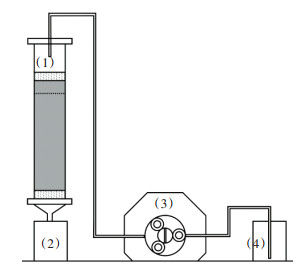
|
(1)淋溶土柱(从上到下:石英砂、尼龙网、土壤、重过磷酸钙、土壤、尼龙网、石英砂);(2)渗滤液;(3)蠕动泵;(4)淋溶液 (1)Leaching soil column(From top to bottom: quartz sand, nylon mesh, soil, heavy superphosphate, soil, nylon mesh, quartz sand); (2)Leachate; (3)Peristaltic pump; (4)Leaching solution 图 1 土柱实验装置图 Figure 1 The sketch of the soil column adsorption experiment |
|
|
表 2 施肥土壤淋溶实验设计梯度 Table 2 The design gradient of leaching experiment of fertilized soil |
为比较磷肥的施加以及不同pH值供试淋溶液对钒释放的影响,需计算土柱中钒的累积释放量和释放率,由式(1)和式(2)得出:

|
(1) |

|
(2) |
式中:q为降雨淋溶下土壤中钒的累积释放量,μg· kg-1;Ci为第i次渗滤液中V浓度,μg·L-1;v为每次收集的渗滤液体积,mL;m为供试土壤及磷肥质量,kg;K为土柱中V的累积释放率;S为土柱内钒的初始含量,包括施加磷肥中钒的含量,μg·kg-1。
1.4 测试方法和数据分析土壤pH值按照中华人民共和国农业行业标准(NY/T 1377—2007),通过PHS-3E型pH计测定,土水比为1:2.5;总有机碳的测定参考中华人民共和国国家环境保护标准(HJ 615—2011);阳离子交换量的测定参考中华人民共和国行业标准(SL 237—1999);土壤机械组成采用马尔文粒径分析仪MS2000进行分析;土壤矿物学特征通过X射线衍射仪分析其物相组成。
渗滤液中总钒浓度是从收集瓶中取25 mL渗滤液,根据HJ 678—2013中的方法消解后用ICP-AES测定。另取12 mL渗滤液,5000 r·min-1离心20 min,取5 mL上清液过0.22 μm滤膜,测定得出渗滤液中溶解态钒的浓度。
土壤中钒总量测定采用0.1 g土样加入5.0 mL硝酸、2.0 mL氢氟酸,放于ST-60型自动消解仪中消解,用ICP-AES测定(检出限为1 ng·g-1);土壤中钒价态的分离采用0.25 g土样加入25 mL 0.1 mol · L-1的Na2CO3溶液,水浴煮沸、冷却、离心、过滤后用ICPAES测定钒(Ⅴ)的含量,钒(Ⅳ)的含量通过总钒含量减去钒(Ⅴ)的含量得到;土壤中钒化学形态的提取采用BCR逐级提取法[38],将重金属形态分为弱酸提取态、可还原态、可氧化态、残渣态。其中,弱酸提取态、可还原态及可氧化态,是能被生物所吸收利用的形态,故三者之和被用于计算有效态钒的含量[39]。
2 结果与讨论 2.1 淋溶过程对土壤理化性质的影响图 2表示在pH值为2.0、4.5和7.0的淋溶条件下,淋溶前后土柱上层3 cm和下层3 cm的土样pH值与TOC值的变化。土壤pH值在淋溶后明显降低,土壤上层pH值普遍低于下层。尤其是在pH=2.0淋溶条件下的土壤,上层pH值比下层低2~3,说明酸雨长期淋溶会造成土壤酸化,尤其对表层土壤影响较大。磷肥的施加对土壤pH值的影响不大。而土壤TOC值在淋溶前后基本保持不变,降雨淋溶和磷肥施加对其影响均不明显。

|
图 2 淋溶前后土壤pH值和TOC值对比 Figure 2 The comparison of soil pH and TOC value before and after leaching |
由图 3可知,渗滤液中溶解态钒和总钒浓度变化趋势基本一致,A1、B1、A2、B2、A3、B3渗滤液中溶解态钒与总钒的相关系数分别为0.878、0.996、0.923、0.973、0.943、0.977,均有非常显著的相关性(P < 0.005)。渗滤液中钒主要以溶解态形式存在(溶解态占比50.8%~90.4%),胶体吸附态含量较低,与胡少平[40]、许端平等[41]认为的渗滤液中重金属主要是以胶体吸附态的形式迁移的观点相反,可能是因为本实验中供试土样未受污染,渗滤液中钒浓度较低,因此胶体颗粒对其他重金属离子的吸附能力更强,且低浓度的钒在溶液中更易达到溶解平衡。
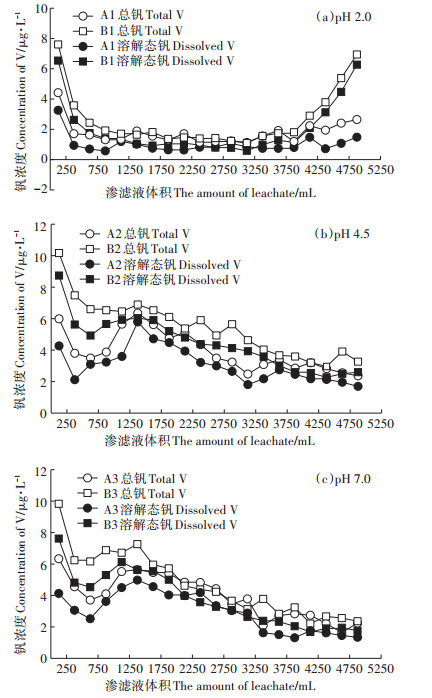
|
图 3 渗滤液中总钒和溶解态钒浓度变化曲线 Figure 3 The concentration variation of total V and dissolved V in leachates |
在pH=2.0的淋溶条件下,渗滤液中溶解态钒和总钒浓度在淋溶前期呈下降趋势,当淋溶量超过4000 mL(淋溶至第16 d)后,渗滤液中溶解态钒和总钒浓度开始增加;而在pH=4.5和pH=7.0淋溶条件下,渗滤液中溶解态钒和总钒浓度整体呈下降趋势。磷肥的施用增加了渗滤液中钒的浓度。
经分析得知,随着淋溶量增加至4000 mL后,在pH=2.0淋溶条件下渗滤液中钒的浓度逐渐高于pH= 4.5和pH=7.0淋溶条件下钒的浓度。可能是因为在淋溶初期,H+与土壤中的重金属化合物和碳酸盐反应,导致H+浓度下降。随着后期淋溶量增大,土壤中可与H+反应的物质越来越少,土壤溶液中H+浓度升高,使得游离钒离子增加,钒的可迁移性增大,渗滤液中钒浓度升高[42-43]。在我国《生活饮用水卫生标准》(GB 5749—2006)中,尽管钒没有列入水质常规检验项目及非常规检验项目,但作为生活饮用水源水质的检验标准,饮用水源水中钒的最高容许浓度为50 μg· L-1。目前渗滤液中钒的浓度并不会对地下水造成危害;但在pH=2.0淋溶条件下,随着淋溶次数的增多,渗滤液中钒浓度逐渐升高,危害地下水环境的几率极大提高。
土柱渗滤液中钒的累积释放量和释放率如表 3所示,在相同模拟降雨条件下,施加2 g·kg-1(以P2O5计)重过磷酸钙的土样B1、B2、B3中钒的释放量分别比未施加磷肥的土样A1、A2、A3中钒的释放量增加了48.7%、36.2%、19.7%,即磷肥的施加增加了土壤中钒的释放,说明磷肥中磷酸根与钒酸根的竞争吸附作用促进了钒的释放,也可能是因为磷肥中可溶态钒含量较高,增加了钒的释放。
|
|
表 3 渗滤液中钒的累积释放量和释放率 Table 3 The cumulative release amount and release rate of V in leachates |
在施肥量相同的条件下,当淋溶液为pH=2.0时,钒的释放量仅为868.1 μg·kg-1和1291.0 μg·kg-1,而在pH=4.5和pH=7.0淋溶条件下,钒的释放量明显增大,即pH=2.0的淋溶条件不利于钒的释放。这是由于土壤溶液中钒主要以+5价的VO3-存在,在一定的降雨量范围内,当酸性增强时,VO3-离子将转化为多钒酸根复合阴离子,易于被黏土和有机质吸附固定而失去活性,即pH在一定范围内的降低增加了土壤对钒的吸附,减少了钒的释放量,与黄艺、汪金舫等的研究结果一致[44-45]。结合图 3进行分析,当降雨淋溶量继续增大时,钒的释放量在强酸性淋溶条件下将会明显增大。总体上,土壤中钒的释放量较低,迁移性较差,与Yang等[16]、商正松等[42]的研究结果一致。
2.3 施肥后土壤中钒形态的转化表 4为原土中总钒含量、各形态钒含量及回收率,表 5和图 4则是淋溶后土壤中总钒及各形态钒含量,土壤中各形态钒含量之和与总钒含量相近,回收率在95.2%~102.8%,说明提取结果准确可信。
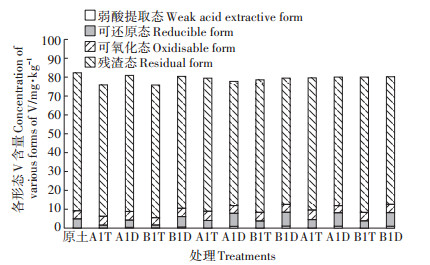
|
图 4 淋溶前后土壤中各形态钒的含量 Figure 4 Content of various forms of V in soil before and after leaching |
|
|
表 4 原土中各形态钒含量、总钒含量(mg·kg-1)及回收率(%) Table 4 The various forms V content, total V content (mg·kg-1) and recovery rate (%) of the original soil |
|
|
表 5 淋溶后土壤中总钒含量及回收率 Table 5 Total V content and recovery rate in soil after leaching |
如表 5所示,淋溶后土壤中钒含量总体低于原土钒含量82.0 mg·kg-1,上下层土壤中钒含量相差不大。在三种不同淋溶条件下,施加磷肥的下层土壤总钒含量稍高于未加磷肥的样点,尤其是在pH=2.0的淋溶条件下,下层总钒含量较上层增加6.6 mg·kg-1,说明长期的酸性溶液淋溶能促进磷肥中钒的释放,增强钒的迁移性,与Cappuyns等[30]研究结果一致。结合表 3渗滤液中钒的累积释放量,在pH=2.0条件下,渗滤液中钒的累积释放量和淋溶后土壤中的钒含量均相对另外两种淋溶条件较少。分析原因可能是:滞留在土柱中间段(除上层和下层土之外)的钒含量较多,且在pH=2.0时,土壤渗滤液中钒含量呈现先下降后上升的趋势,在pH=4.5和pH=7.0的条件下,渗滤液中钒含量呈现明显的下降趋势;因此随着总淋溶量的增大,pH=2.0条件下渗滤液中钒释放量增加的速度加快,钒的累积释放量增加的幅度变大。
淋溶前后土壤各形态钒含量如图 4所示,对于弱酸提取态钒,未施加磷肥的下层土壤A1D、A2D、A3D中,含量分别为0.44、0.95、1.04 mg·kg-1;施加磷肥的下层土壤B1D、B2D、B3D中,含量分别为0.62、1.09、1.01 mg·kg-1。由此可见,经过pH=2.0渗滤液淋溶过的土壤下层弱酸提取态钒的含量比另外两种淋溶条件低;对于可还原态钒,经过pH=2.0渗滤液淋溶过的土壤,其上、下层的可还原态钒含量均低于另外两种淋溶条件下钒的含量。总体上,对比淋溶后的土壤上下层,弱酸提取态钒和可还原态钒含量下层明显高于上层,可氧化态钒含量差别不大,而残渣态钒含量下层低于上层,说明下层增加的弱酸提取态钒和可还原态钒,可能来自上层残渣态钒的溶解。
淋溶后土壤上、下层各形态钒所占比例如图 5所示。经过淋溶后,上层土壤中弱酸提取态钒所占比例与原土基本一致,而下层土壤中则显著高于原土;对于可还原态钒,原土中所占比例为5.85%,上层土壤可还原态钒所占比例均低于下层土和原土;对于残渣态钒,原土中占89.15%,淋溶后土壤中残渣态钒仍占有最大比例,且在pH=2.0淋溶条件下比pH=4.5和pH= 7.0淋溶条件下的土壤中残渣态钒所占比例更大,这与弱酸提取态钒和可还原态钒恰好相反。
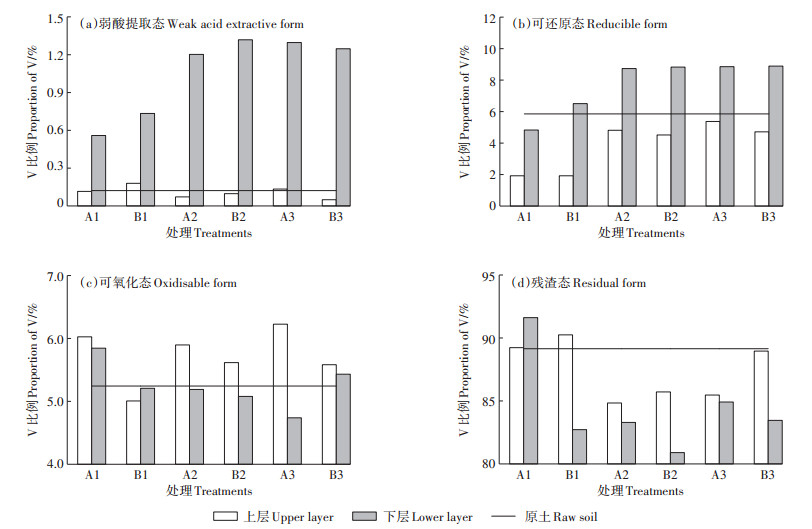
|
图 5 淋溶前后土壤中各形态钒所占比例 Figure 5 The proportion of various forms of V in soil before and after leaching |
重金属的化学形态是影响重金属有效性、溶解性和迁移性最重要的因素之一[46],一般认为在利用BCR法逐级提取的化学形态中,具有生物有效性的形态是弱酸提取态、可还原态及可氧化态。因此,三种淋溶条件均增加了下层土壤中钒的生物有效性,尤其是pH=4.5和pH=7.0两种淋溶条件。另外,磷肥的施加对pH=4.5和pH=7.0淋溶的土壤中钒的生物有效性影响不大,但是增加了pH=2.0淋溶的土壤中钒的生物有效性。
2.4 施肥后土壤中钒价态的转化土壤中钒常见的价态是+4价和+5价,而钒的毒性随价态的升高而增强,其中钒(Ⅴ)具有较强的迁移性和生物有效性,对环境危害较大[47]。如图 6所示,原土中钒(Ⅴ)和钒(Ⅳ)的含量分别为4.5 mg·kg-1及77.65 mg·kg-1;在pH=2.0淋溶条件下,上层土壤中钒(Ⅳ)和钒(Ⅴ)含量均低于原土,而下层土壤中钒(Ⅴ)含量增加,说明酸性降雨淋溶增加了土壤中钒(Ⅴ)的迁移量,并在下层累积;在pH=4.5和pH=7.0淋溶条件下,下层土壤中钒(Ⅴ)含量明显增加,钒(Ⅳ)含量有所降低,说明在一定pH条件下土壤中部分钒(Ⅳ)被氧化为钒(Ⅴ),与邹宝方等研究结果一致[48]。
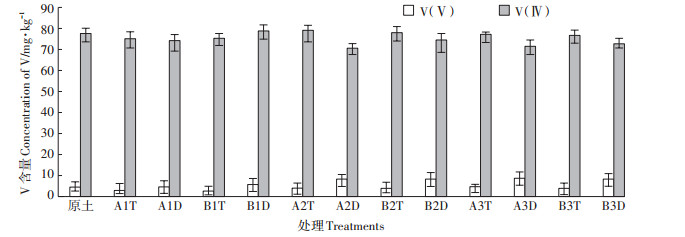
|
图 6 土壤中钒(Ⅳ)和钒(Ⅴ)的含量 Figure 6 The content of V(Ⅳ)and V(Ⅴ)in soil |
图 7表示淋溶前后土壤钒(Ⅴ)所占比例,已知原土中钒(Ⅴ)所占比例为5.4%,淋溶后上层土壤中钒(Ⅴ)所占比例减小,下层明显增加。pH=2.0淋溶条件下,土壤中钒(Ⅴ)所占比例明显较pH=4.5和pH=7.0淋溶条件低,说明在pH值升高时,土壤中部分钒(Ⅳ)被氧化为钒(Ⅴ),与邹宝方等[48]、Baes等[49]的研究一致。

|
图 7 淋溶前后土壤中钒(Ⅴ)所占比例 Figure 7 The proportion of V(Ⅴ)in soil before and after leaching |
为探究土壤中钒含量变化的影响因素,利用SPSS16.0软件对淋溶后12个土壤样品(A1T、A1D、A2T、A2D、A3T、A3D、B1T、B1D、B2T、B2D、B3T、B3D)pH值、TOC、有效态钒、钒(Ⅴ)以及总钒含量进行相关性分析。如表 6所示,土壤pH值与有效态钒含量表现出极显著正相关(P < 0.01),与钒(Ⅴ)表现出显著正相关(P < 0.05),说明在一定降雨量范围内,酸性降雨的淋溶会降低土壤中有效态钒与钒(Ⅴ)含量;土壤TOC与其他指标相关性差,淋溶后TOC未发生明显变化;有效态钒含量与钒(Ⅴ)含量的相关系数达到了0.958(P < 0.01),说明钒(Ⅴ)含量的增加会导致土壤中钒的生物有效性增强,对环境造成较大危害,因此土壤中钒(Ⅴ)的含量也可作为土壤中钒潜在危害的评价指标。
|
|
表 6 土壤相关性分析表(N=12) Table 6 Correlation analysis table of soil (N=12) |
(1)磷肥的施加可促进土壤中钒的迁移和累积。在强酸性淋溶条件下,土壤渗滤液中钒含量呈现先下降后上升的趋势;在弱酸性和中性降雨条件下,土壤渗滤液中钒含量呈现明显的下降趋势。整体上钒的释放量较小,且渗滤液中钒主要以溶解态形式存在。
(2)淋溶过程影响了土壤中残渣态钒向弱酸提取态和可还原态的转化,增加了下层土壤中有效态钒的含量。酸性降雨条件下,磷肥的施加促进了下层土壤中有效态钒的累积。
(3)酸性和自然降雨模拟条件下,土壤中部分钒(Ⅳ)被氧化为钒(Ⅴ),同时磷肥的使用也促进了下层土壤中钒(Ⅴ)的累积,增加了土壤中钒的生物有效性。
(4)相关性分析结果表明,影响土壤中钒迁移转化的主要因素是土壤pH值,且土壤中钒(Ⅴ)与有效态钒含量呈极显著相关。因此土壤中钒(Ⅴ)含量可作为土壤中钒潜在危害的评价指标。
| [1] |
丁旭彤, 蒋建国, 李德安, 等. 钙基固化剂对钒矿污染土壤固化效果的研究[J]. 农业环境科学学报, 2016, 35(2): 274-280. DING Xu-tong, JIANG Jian-guo, LI De-an, et al. Immobilizing effects of calcium-based agents on soil contaminated by vanadium ore[J]. Journal of Agro-Environment Science, 2016, 35(2): 274-280. |
| [2] |
矫旭东, 滕彦国. 土壤中钒污染的修复与治理技术研究[J]. 土壤通报, 2008, 39(2): 448-452. JIAO Xu-dong, TENG Yan-guo. Techniques on soil remediation and disposal of vanadium pollution[J]. Chinese Journal of Soil Science, 2008, 39(2): 448-452. DOI:10.3321/j.issn:0564-3945.2008.02.048 |
| [3] |
刘梦, 王华静, 王鲲鹏, 等. 腐植酸对水体中五价钒的吸附[J]. 农业环境科学学报, 2016, 35(5): 969-975. LIU Meng, WANG Hua-jing, WANG Kun-peng, et al. Adsorption of pentavalent vanadium by humic acid in water[J]. Journal of Agro-Environment Science, 2016, 35(5): 969-975. |
| [4] |
Smith P G, Boutin C, Knopper L. Vanadium pentoxide phytotoxicity:Effects of species selection and nutrient concentration[J]. Archives of Environmental Contamination & Toxicology, 2013, 64(1): 87-96. |
| [5] |
Ehrlich V A, Nersesyan A K, Hoelzl C, et al. Inhalative exposure to vanadium pentoxide causes DNA damage in workers:Results of a multiple end point study[J]. Environmental Health Perspectives, 2008, 116(12): 1689. DOI:10.1289/ehp.11438 |
| [6] |
Panichev N, Mandiwana K, Moema D, et al. Distribution of vanadium (Ⅴ)species between soil and plants in the vicinity of vanadium mine[J]. Journal of Hazardous Materials, 2006, 137(2): 649-653. DOI:10.1016/j.jhazmat.2006.03.006 |
| [7] |
Mukherjee B, Patra B, Mahapatra S, et al. Vanadium:An element of a typical biological significance[J]. Toxicology Letters, 2004, 150(2): 135-143. |
| [8] |
Krystyna Pyrzyńska, Tomasz Wierzbicki. Determination of vanadium species in environmental samples[J]. Talanta, 2004, 64(4): 823-829. DOI:10.1016/j.talanta.2004.05.007 |
| [9] |
曾昭华, 廖苏平, 曾雪萍. 中国癌症与土壤环境中钒元素的关系[J]. 吉林地质, 2002, 21(3): 93-98. ZENG Zhao-hua, LIAO Su-ping, ZENG Xue-ping. The relation between the cancer in China and V element in the soil environment[J]. Jilin Geology, 2002, 21(3): 93-98. DOI:10.3969/j.issn.1001-2427.2002.03.016 |
| [10] |
Liu Y, Liu G, Qi C, et al. Chemical speciation and combustion behavior of chromium(Cr)and vanadium(Ⅴ)in coals[J]. Fuel, 2016, 184: 42-49. DOI:10.1016/j.fuel.2016.07.003 |
| [11] |
Hope B K. A dynamic model for the global cycling of anthropogenic vanadium[J]. Global Biogeochemical Cycles, 2008, 22(4). |
| [12] |
曾英, 倪师军, 张成江. 钒的生物效应及其环境地球化学行为[J]. 地球科学进展, 2004, 472-476. ZENG Ying, NI Shi-jun, ZHANG Cheng-jiang, et al. Biological effect and environmental geochemical behavior of vanadium[J]. Advance in Earth Science, 2004(Suppl1): 472-476. |
| [13] |
Moskalyk R R, Alfantazi A M. Processing of vanadium:A review[J]. Minerals Engineering, 2003, 16(9): 793-805. DOI:10.1016/S0892-6875(03)00213-9 |
| [14] |
Adriano D C. Trace elements in terrestrial environments[J]. Quarterly Review of Biology, 2001, 32(1): 374. |
| [15] |
李天然, 蒋建国, 李德安, 等. 铁基固体材料对钒矿污染土壤的固化效果研究[J]. 中国环境科学, 2016, 36(7): 2108-2114. LI Tian-ran, JIANG Jian-guo, LI De-an, et al. Solidifying effect of heavy metals in the vanadium deposit-polluted soil by iron-based solid agents[J]. China Environmental Science, 2016, 36(7): 2108-2114. DOI:10.3969/j.issn.1000-6923.2016.07.030 |
| [16] |
Yang J, Tang Y, Yang K, et al. Leaching characteristics of vanadium in mine tailings and soils near a vanadium titanomagnetite mining site[J]. Journal of Hazardous Materials, 2014, 264(2): 498-504. |
| [17] |
Li M T, Wei C, Zhou X J, et al. Kinetics of vanadium leaching from black shale in non-oxidative conditions[J]. Mineral Processing & Extractive Metallurgy, 2013, 121(1): 40-47. |
| [18] |
滕彦国, 郑艳红, 郑晓霞, 等. 攀枝花钢铁冶炼废渣中重金属钒的浸出释放特征[J]. 地球科学进展, 2012, 415-418. TENG Yan-guo, ZHENG Yan-hong, ZHENG Xiao-xia, et al. Leaching and release characteristics of heavy metal vanadium from Panzhihua iron and steel smelting waste[J]. Advance in Earth Science, 2012(Suppl1): 415-418. |
| [19] |
Wang M, Xiao L, Li Q, et al. Leaching of vanadium from stone coal with sulfuric acid[J]. Rare Metals, 2009, 28(1): 1-4. DOI:10.1007/s12598-009-0001-y |
| [20] |
Otero N, Vitòria L, Soler A, et al. Fertiliser characterisation:Major, trace and rare earth elements[J]. Applied Geochemistry, 2005, 20(8): 1473-1488. DOI:10.1016/j.apgeochem.2005.04.002 |
| [21] |
周南华. 化肥施用与农产品质量安全[J]. 西南农业学报, 2004, 17(1): 126-130. ZHOU Nan-hua. Fertilizer application and quality security of farm products[J]. Southwest China Journal of Agricultural Sciences, 2004, 17(1): 126-130. DOI:10.3969/j.issn.1001-4829.2004.01.030 |
| [22] |
高强, 刘淑霞, 王宇, 等. 施肥对农业生态环境的影响[J]. 吉林农业大学学报, 2000, Suppl1: 106-112. GAO Qiang, LIU Shu-xia, WANG Yu, et al. Effect of fertilization on agro-ecological environment[J]. Journal of Jilin Agricultural University, 2000, Suppl1: 106-112. |
| [23] |
Senesi G S, Baldassarre G, Senesi N, et al. Trace element inputs into soils by anthropogenic activities and implications for human health[J]. Chemosphere, 1999, 39(2): 343-377. DOI:10.1016/S0045-6535(99)00115-0 |
| [24] |
王洪君, 王楠, 梁烜赫, 等. 施磷肥对土壤-水稻体系中Hg迁移累积规律的影响[J]. 吉林农业大学学报, 2011, 33(6): 666-671. WANG Hong-jun, WANG Nan, LIANG Xuan-he, et al. Influence of phosphate fertilizer on Hg accumulation in the soil-rice system[J]. Journal of Jilin Agricultural University, 2011, 33(6): 666-671. |
| [25] |
Molina M, Aburto F, Calderon R, et al. Trace element composition of selected fertilizers used in Chile:Phosphorus fertilizers as a source of long-term soil contamination[J]. Soil and Sediment Contamination, 2009, 18(4): 497-511. DOI:10.1080/15320380902962320 |
| [26] |
Nicholson F A, Smith S R, Alloway B J, et al. An inventory of heavy metals inputs to agricultural soils in England and Wales[J]. Science of the Total Environment, 2003, 311. |
| [27] |
Jiao W, Chen W, Chang A C, et al. Environmental risks of trace elements associated with long-term phosphate fertilizers applications:A review[J]. Environ Pollut, 2012, 168: 44-53. DOI:10.1016/j.envpol.2012.03.052 |
| [28] |
郭娟, 罗小丽, 姚爱军, 等. 模拟酸雨条件下铁硅材料和生物炭对土壤镉砷形态及生物有效性的影响[J]. 农业环境科学学报, 2018, 37(7): 1495-1502. GUO Juan, LUO Xiao-li, YAO Ai-jun, et al. Effects of iron-silicon material and biochar on soil Cd and As speciation and vegetable uptake under[J]. Journal of Agro-Environment Science, 2018, 37(7): 1495-1502. |
| [29] |
Bo Z, An L, Wu G, et al. Characterization of heavy metal desorption from road-deposited sediment under acid rain scenarios[J]. Journal of Environmental Sciences, 2017, 51(1): 284-293. |
| [30] |
Cappuyns V, Swennen R. Release of vanadium from oxidized sediments:Insights from different extraction and leaching procedures[J]. Environmental Science & Pollution Research International, 2014, 21(3): 2272-2282. |
| [31] |
饶中秀, 朱奇宏, 黄道友, 等. 模拟酸雨条件下海泡石对污染红壤镉、铅淋溶的影响[J]. 水土保持学报, 2013, 27(3): 23-27. RAO Zhong-xiu, ZHU Qi-hong, HUANG Dao-you, et al. Effects of sepiolite on Cd and Pb leaching in contaminated red soil under simulated acid rain[J]. Journal of Soil and Water Conservation, 2013, 27(3): 23-27. |
| [32] |
Zeng F, Ali S, Zhang H, et al. The influence of pH and organic matter content in paddy soil on heavy metal availability and their uptake by rice plants[J]. Environ Pollut, 2011, 159(1): 84-91. DOI:10.1016/j.envpol.2010.09.019 |
| [33] |
钟晓兰, 周生路, 李江涛, 等. 模拟酸雨对土壤重金属镉形态转化的影响[J]. 土壤, 2009, 41(4): 566-571. ZHONG Xiao-lan, ZHOU Sheng-lu, LI Jiang-tao, et al. Effect of simulated acid rains on Cd form transformation in contaminated soil[J]. Soils, 2009, 41(4): 566-571. DOI:10.3321/j.issn:0253-9829.2009.04.010 |
| [34] |
He J, Yang J, Tian L, et al. Bioaccessibility of vanadium from soil and mineral measured by in vitro model[J]. Agricultural Science & Technology, 2012, 13(10): 2142-2146. |
| [35] |
Teng Y, Yang J, Sun Z, et al. Environmental vanadium distribution, mobility and bioaccumulation in different land-use districts in Panzhihua Region, SW China[J]. Environmental Monitoring and Assessment, 2011, 176(1/2/3/4): 605-620. |
| [36] |
Emberyová M, Jankovi R, Hagarová I, et al. Electrothermal atomic absorption spectrometric determination of vanadium in extracts of soil and sewage sludge certified reference materials after fractionation by means of the Communities Bureau of Reference modified sequential extraction procedure[J]. Spectrochimica Acta Part B:Atomic Spectroscopy, 2007, 62(5): 509-513. DOI:10.1016/j.sab.2007.05.004 |
| [37] |
汪金舫, 刘铮. 土壤中钒的化学结合形态与转化条件的研究[J]. 中国环境科学, 1995, 15(1): 34-39. WANG Jin-fang, LIU Zheng. Studies on chemical forms of vanadium in soil and their transformation[J]. China Environmental Science, 1995, 15(1): 34-39. DOI:10.3321/j.issn:1000-6923.1995.01.011 |
| [38] |
Quevauviller P, Rauret G, Griepink B. Conclusions of the workshopsingle and sequential extraction in sediments and soils[J]. International Journal of Environmental Analytical Chemistry, 1993, 51(1/2/3/4): 231-235. |
| [39] |
Yang J, Teng Y, Zuo R, et al. Comparison of bioavailable vanadium in alfalfa rhizosphere soil extracted by an improved BCR procedure and EDTA, HCl, and NaNO3, single extractions in a pot experiment with V -Cd treatments[J]. Environmental Science & Pollution Research International, 2015, 22(12): 8833-8842. |
| [40] |
胡少平.土壤重金属迁移转化的分子形态研究[D].杭州: 浙江大学, 2009. HU Shao-ping. Molecular speciation of heavy metals transportation in soil[D]. Hangzhou: Zhejiang University, 2009. http://d.wanfangdata.com.cn/Thesis/Y1647024 |
| [41] |
许端平, 崔芳菲, 李翰良, 等. 污染土壤胶体释放特征及其对锌运移的作用[J]. 环境工程学报, 2015(5): 2495-2502. XU Duan-ping, CUI Fang-fei, LI Han-liang, et al. Releasing characteristics of colloids from contaminated-soil and their effect on transportation of zinc[J]. Chinese Journal of Environmental Engineering, 2015(5): 2495-2502. |
| [42] |
商正松, 刘方, 刘荣, 等. 酸性淋溶下湘西钒矿区废渣及土壤重金属的释放特征[J]. 环保科技, 2011, 17(2): 10-14. SHANG Zheng-song, LIU Fang, LIU Rong, et al. The release characteristics of heavy metals in vanadium waste and contaminated soil in the west of Hunan under acid leaching condition[J]. Environmental Protection and Technology, 2011, 17(2): 10-14. DOI:10.3969/j.issn.1674-0254.2011.02.003 |
| [43] |
白梅, 铁柏清, 尹倩. 降雨对土壤中重金属淋失的影响[J]. 环境科学与技术, 2010(增刊2): 80-82. BAI Mei, TIE Bo-qing, YIN Qian. The effect of rainfall on the leaching loss of soil heavy metal[J]. Environmental Science & Technology, 2010(Suppl2): 80-82. |
| [44] |
黄艺, 张仕鹏, 倪师军, 等. 矿业城市攀枝花土壤中微量重金属元素钒的形态分布研究[J]. 广东微量元素科学, 2005, 12(11): 28-33. HUANG Yi, ZHANG Shi-peng, NI Shi-jun, et al. Study on speciation analysis of vanadium in soil of mining city Panzhihua[J]. Guangdong Trace Elements Science, 2005, 12(11): 28-33. DOI:10.3969/j.issn.1006-446X.2005.11.007 |
| [45] |
汪金舫, 刘铮. 钒在土壤中的含量分布和影响因素[J]. 土壤学报, 1994, 31(1): 61-67. WANG Jin-fang, LIU Zheng. Vanadium distribution and its affecting factors in soils of China[J]. Acta Pedologica Sinica, 1994, 31(1): 61-67. DOI:10.3321/j.issn:0564-3929.1994.01.008 |
| [46] |
Carrillo-Gonzalez R, Simunek J, Sauve S, et al. Mechanisms and pathways of trace element mobility in soils[J]. Advances in Agronomy, 2006, 91(6): 111-178. |
| [47] |
Mandiwana K L, Panichev N. Electrothermal atomic absorption spectrometric determination of vanadium(Ⅴ)in soil after leaching with Na2CO3[J]. Analytica Chimica Acta, 2004, 517(1): 201-206. |
| [48] |
邹宝方, 何增耀. 钒的环境化学[J]. 环境污染与防治, 1993, 15(1): 26-31. ZOU Bao-fang, HE Zeng-yao. Environmental chemistry of vanadium[J]. Environmental Pollution & Control, 1993, 15(1): 26-31. |
| [49] |
Baes J, Charles F, Mesmer R E. The hydrolysis of cations[M]. New York: John Wiley & Sons, 1976.
|
 2019, Vol. 38
2019, Vol. 38





